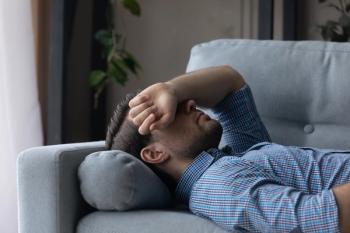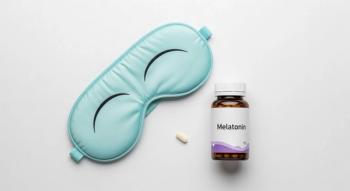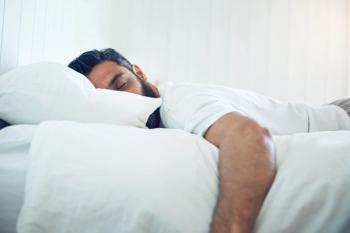
- Psychiatric Times Vol 11 No 7
- Volume 11
- Issue 7
Hypnotics and the Perception of Wakefulness
Insomnia, the subjective sense of having inadequate quantity orquality of sleep, may result from a variety of causes. In itschronic form, such etiologies may include psychiatric disorderssuch as depression or anxiety, medical illnesses, medications,substance abuse, circadian dysrhythmias and pathophysiologiesintrinsic to sleep such as sleep apnea or periodic movement disorder.When these conditions have been ruled out, however, there remaintwo very interesting groups that at this time are best understoodin psychophysiological terms.
Insomnia, the subjective sense of having inadequate quantity orquality of sleep, may result from a variety of causes. In itschronic form, such etiologies may include psychiatric disorderssuch as depression or anxiety, medical illnesses, medications,substance abuse, circadian dysrhythmias and pathophysiologiesintrinsic to sleep such as sleep apnea or periodic movement disorder.When these conditions have been ruled out, however, there remaintwo very interesting groups that at this time are best understoodin psychophysiological terms.
In the first form, conditioned insomnia ("chronic psychophysiologicinsomnia"), sleep is disrupted because the act of going tosleep has become associated with anxiety-related behaviors incompatiblewith sleep, and excessive efforts are made to try to fall asleepthat are counterproductive (Mendelson, 1987).
The second form is subjective insomnia, characterized by a disparitybetween the degree of sleep disturbance reported by the patientand that seen by a sleep study (polysomnography). Typically, sucha patient will come to the clinic complaining of taking an hourto fall asleep and then sleeping only three hours. The sleep study,however, might reveal that in physiologic terms he or she fellasleep in 30 minutes and slept six hours.
If the unwary physician should later meet with the patient andreport that he or she "in fact" did sleep adequately,the patient is unlikely to believe such report. Also, the patientmay feel that the doctor doesn't believe him or her. Such intriguingand difficult patients are the subject of this paper, and forshorthand they will be referred to as "insomniacs."
Subjective Insomnia
One of the first insights into subjective insomnia came from theclassic study by Rechtschaffen (1968), in which he reported thatwhen poor sleepers were awakened 10 minutes after the first sleepspindle, they were more likely to report that they had been awake;in contrast, good sleepers were more likely to report that theyhad been asleep.
Moore and colleagues, Coates and colleagues, and Mendelson andcolleagues subsequently described a similar phenomenon. The modelwhich we used involved awakening the subject with a 500 Hz electronictone of progressively increasing amplitude (two dB every threeseconds) at five time points across the night:
- 5 minutes after "lights out," at which time subjectshave empirically been found to be awake;
- 10 minutes after the first sleep spindle (in all studies subjectshave been in Stage 2 sleep at that point);
- 10 minutes after the onset of Stage 4 sleep;
- 5 minutes after the onset of rapid eye movement (REM) sleep;
- during the first period of spontaneous waking time after thefirst REM period.Forced Arousals
During these events, which we shall refer to as "forced arousals,"an investigator enters the room and asks each subject a seriesof questions, including whether he or she was awake or asleepand whether the subject had been dreaming. The investigator alsoadministers a brief rating scale, the Dream Complexity Scale (Foulkesand Vogel), which helps determine the subject's perception ofstate of consciousness. These data, combined with the polygraphicsleep stage and a measure of the amplitude of the electronic tone,provide the basic observations which we shall discuss.
In our 1986 study that contrasted insomniacs and age- and sex-matchedcontrols, the amplitude of the electronic tone needed to awakenthe insomniacs and good sleepers was similar, suggesting thatsubjectively poor sleep may not necessarily be the same as "light"sleep (as determined by the amplitude of a stimulus needed toinduce an arousal). It was found, though, that insomniacs reportedhaving been awake in 71 percent of the forced arousals acrossall time points; this was significantly (p<0.05) more oftenthan the 44.6 percent found in the normal controls. The consistencyof this observation suggests its incorporation into any theoryof the mechanism of insomnia, and the implication to us has beenthat insomniacs may suffer from a dissociation between the perceptionof being awake or asleep and the physiologic measures of wakingand sleep, at least as we know how to assess them at this point.
- Hypnotic Medications
A second insight into insomnia may come by studying medicationsused to treat it: clinically used hypnotics such as thebenzodiazepines and newer nonbenzodiazepine hypnotics such aszolpidem (Ambien). There seems little doubt that in a short-termsense, i.e., measured in terms of a few nights, they provide substantialrelief from insomnia, as measured by the patient's report in themorning (although in chronic nightly use their benefits are lessclear due to issues of tolerance). Indeed their acceptance bypatients is striking. Although hypnotics are substantially lesswidely used than antidepressants, nonetheless approximately 2percent to 3 percent of the population has taken them sometimein the past year, according to Mellinger and Balter. Shader andcolleagues found that approximately 20 million prescriptions arewritten annually for this purpose.
One interpretation would seem to be that many patients get relieffrom these agents. Such a view would be supported by the observationof Balter and Uhlenhuth that approximately 70 percent to 80 percentof people who have taken the most common benzodiazepine hypnoticsin the past year say that they would want to take the medicationagain should the need arise.
In contrast to this relatively high rate of acceptance of clinicalhypnotics, at least for short-term use, is what I believe to berelatively modest improvement in polygraphic measures of sleep.To give but a few examples:
In one of the major studies of the efficacy of flurazepam (Dalmane),a 30 mg dose led to an increase in total sleep of only 6 percentto 8 percent during one month of administration; sleep onset timewas improved only on nights 11 through 13 (Kales and associates,1975).
When 30 mg flurazepam was given to insomniacs for five weeks,total sleep rose by only 21 minutes (Mitler et al., 1984).
A one-week trial of 15 mg flurazepam given to insomniacs forone week increased sleep by a mean of only 29 minutes (Roehrsand colleagues, 1982).
Patients on chronic low doses of benzodiazepines have similarsleep to nonmedicated insomniacs in terms of total sleep, sleeponset time and waking time after initial sleep onset (Schneider-Helmert,1988).
A multicenter study of 99 insomniacs receiving 15 or 30 mg flurazepamor 15 mg midazolam (Versed) for two weeks found no polygraphicimprovement of sleep on the first night with flurazepam, althoughpatients reported in the morning that they believed that theyhad slept longer (Kripke et al., 1990). The few significant polygraphicimprovements in sleep with either drug were only on the firsttwo nights.
A literature review of all studies of hypnotics that achievedbasic standards of quality found that they increased sleep bya mean of only 35 minutes (Gillin and Mendelson, 1981).
- Two Hypotheses
Given such widespread subjective reports of improved sleep withbenzodiazepines (e.g., Rickels), and these relatively modest improvementsin polygraphically measured sleep, two possible hypotheses cometo mind: First, in the future, efficacy will be demonstrated moresubstantially as subtler polygraphic measures are developed. Second,the benefits of hypnotics on subjective sleep may involve mechanismsother than altering features that can be detected polygraphically.In an effort to explore this latter possibility, we have givenvarious clinically used hypnotics and placebo to insomniacs inthe experimental paradigm previously described.
In an early study we gave the benzodiazepine hypnotic triazolam(Halcion) 0.25 mg to insomniacs 30 minutes before bedtime (Mendelsonand Maczaj, 1990). There was an increase in the auditory arousalthreshold five minutes after "lights out," during Stage2, and intermittent waking time (it seems likely this was notas evident during Stage 4 and REM sleep, due to their higher arousalthresholds with placebo).
- Non-REM Sleep
Although the only drug effect evident on the polysomnogram wasan increase in non-REM sleep, the insomniacs reported in the morningthat their sleep was deeper and more restful, that they had fallenasleep more quickly and slept longer than on placebo. During theforced arousals from Stage 4 sleep, they were more likely to reporthaving been asleep on nights with active drug compared to placebo.Thus, in spite of relatively modest improvements in the sleepEEG, their overall impression was that sleep was markedly improved.
- Follow-Up Study
In a follow-up study reported in 1993, we gave three doses oftriazolam (0.125, 0.25 and 0.375 mg) and placebo to 15 insomniacs,and again awakened them at the same five time points across thenight. On the active drug nights, the insomniacs were only halfas likely to report that they had been awake compared to placebonights, at all time points combined. In more recent work (Mendelson,submitted), we have determined that this effect is not uniqueto triazolam, as it also occurs with 10 mg of zolpidem. On placebonights, insomniacs reported having been asleep in only 30.9 percentof forced arousals, while after zolpidem, this rose to 54.7 percent(p<0.03). This effect seems specific to drug actions on insomniacs,insofar as a similar study with normal volunteers found no drug-inducedalterations in the percentage of reports of having been awakeor asleep (Mendelson, submitted).
- Synthesis of Studies
Several interpretations of these studies could be considered.One of these, mentioned earlier, is that insomniacs may sufferfrom a difficulty in perception of being awake or asleep, andin effect have a dissociation of the experience of being awakeor asleep and the traditional polygraphic measures of these states.
If so, one interpretation of the considerable and subjective benefitsof these drugs-in the context of relatively modest polygraphicimprovement-might be that one aspect of their therapeutic effect(as measured by morning reports of improved sleep) involves drug-inducedalterations in the perception of being awake or asleep. In effect,after taking some hypnotics, insomniacs may behave more like normalcontrols in terms of their ability to perceive wakefulness andsleep. In normal controls a drug effect is not seen because thereis not a significant subjective/objective sleep dissociation inbaseline conditions.
- Cognitive & Side Effects
In closing, I would like to mention one interesting speculationabout hypnotic medications. Virtually all benzodiazepine hypnoticshave been reported to have various effects on cognition. Accordingto Greenblatt, these can usually be predicted by the kineticsof the particular compound. Traditionally, such actions have beenconsidered undesirable side effects, and much effort is beingexpended to develop "specific" hypnotics that inducesleep without altering cognition. One possibility that we mightconsider, however, is whether such an ideal drug would be possible.If indeed one mechanism by which hypnotics improve subjectivemeasures of sleep is by altering perception of wakefulness, itmay be that the cognitive "side effects" of these drugsare in actuality a reflection of the therapeutic effect, whenthe drug's kinetics are such that it is seen in the daytime.
Acknowledgment: The study by Mendelson (1993) and the two studiesby Mendelson (submitted) were partially supported by NIMH grantno. 1RO1MH4776901. The study of Mendelson and Maczaj (1990) waspartially supported by a grant from the Upjohn Co.
References:
- References1. Balter MB, Uhlenhuth EH. The beneficial and adverse effectsof hypnotics. J Clin Psychiatry. 1991;52:16-23.
2. Coates TJ, Killen JD, Silberman S, et al. Cognitive activity,sleep disturbance, and stage specific differences between recordedand reported sleep. Psychopharmacol. 1983;20:243.
3. Foulkes D, Vogel G. Mental activity at sleep onset. J AbnormPsychol. 1965;70:231-243.
4. Gillin JC, Mendelson WB. Sleeping pills: For whom? When? Howlong? In: Palmer GC, ed. Neuropharmacology of Central NervousSystem and Behavioral Disorders. New York: Academic Press;1981.
5. Greenblatt DJ, Harmatz JS, Engelhardt N, Shader RI. Pharmacokineticdeterminants of dynamic differences among three benzodiazepinehypnotics. Arch Gen Psychiatry. 1989;46:326-332.
6. Kales A, Kales JD, Bixler EO, Scharf MB. Effectiveness of hypnoticdrugs with prolonged use: flurazepam and pentobarbital. ClinPharmacol Ther. 1975;18:356-363.
7. Kripke DF, Hauri P, Ancoli-Israel S, Roth T. Sleep evaluationin chronic insomniacs during 14 day use of flurazepam and midazolam.J Clin Psychopharmacol. 1990;10:32S-43S.
8. Mellinger GD, Balter ML. Psychotherapeutic drugs: a currentassessment of prevalence and patterns of use. In: Morgan JP, KaganDV, eds. Society and Medication: Conflicting Signals for Prescribersand Patients. Lexington, Mass.: D.C. Health 1983; 137-154.
9. Mendelson WB. Human Sleep: Research and Clinical Care. NewYork: Plenum; 1987.
10. Mendelson WB. Pharmacologic alteration of the perception ofbeing awake or asleep. Sleep. 1993;16:641-646.
11. Mendelson WB, Maczaj M. Effects of triazolam on the perceptionof sleep and wakefulness in insomniacs. Ann Clin Psychiatry.1990;2:211-216.
12. Mendelson WB, James SP, Garnett D, Sack DA, Rosenthal NE.A psychophysiological study of insomnia. Psychiatry Res.1986;19:267-284.
13. Mitler MM, Seidel WB, Van den Hoed J, Greenblatt DJ, DementWC. Comparative hypnotic effects of flurazepam, triazolam andplacebo: a long-term simultaneous nighttime and daytime study.J Clin Psychopharmacol. 1984;4:2-13.
14. Moore SE, Bonnet MH, Warm JS. Estimates of sleep latency inthe morning and at sleep onset in insomniac and normal subjects.Sleep Res. 1991;10:219.
15. Rechtschaffen A. Polygraphic aspects of insomnia. In: GastautH, Lugaresi E, Berti-Ceroni G, eds. The Abnormalities of Sleepin Man. Bologna, Italy: Gaggi; 1968.
16. Rickels K. Clinical trials of hypnotics. J Clin Psychopharmacol.1983;3:133-142.
17. Roehrs T, Zorick F, Kaffeman M, Sicklesteel BA, Roth T. Flurazepamfor short-term treatment of complaints of insomnia. J ClinPharmacol. 1982;22:290-296.
18. Shader RI, Greenblatt DJ, Balter MB. Appropriate use and regulatorycontrol of benzodiazepines. J Clin Psychopharmacol. 1991;31:781-784.
19. Schneider-Helmert D. Why low-dose benzodiazepine-dependentinsomniacs can't escape their sleeping pills. Acta PsychiatrScand. 1988;78:706-711
Articles in this issue
over 31 years ago
Sleep Disturbances with Substances of Abuse and Dependenceover 31 years ago
A Psychiatrist's Primer on Sleep ApneaNewsletter
Receive trusted psychiatric news, expert analysis, and clinical insights — subscribe today to support your practice and your patients.

















